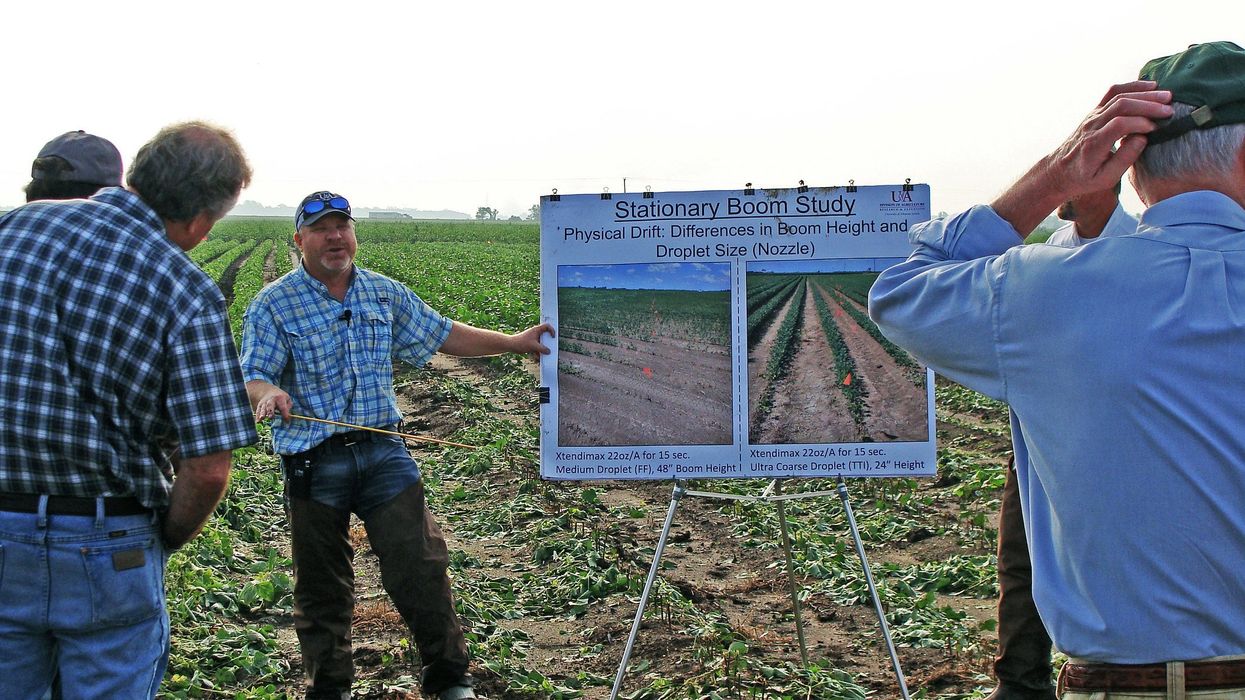
This story was originally published in The New Lede, a journalism project of the Environmental Working Group, and is republished here with permission.
In December 2021, a small team of scientists working for the U.S. Environmental Protection Agency (EPA) issued a stark report on a controversial weed killer that had been the subject of years of complaints from farmers and environmentalists.
Despite new restrictions, the government scientists confirmed that the damage from the weed killer known as dicamba was nearly impossible to contain; once sprayed onto targeted farm fields where genetically engineered crops were designed to withstand the chemical, dicamba then easily and frequently moved far off target to harm millions of acres of other crops and endangered species. The agency scientists concluded that because of these broad risks, it was doubtful that dicamba, used on tens of millions acres of cotton and soybean crops in the U.S., could legally be kept on the market.
“EPA has reason to believe the number of incidents reported significantly understates the actual number of incidents related to dicamba use,” the agency said at the time.
Despite the public acknowledgements of the problems posed by dicamba, the EPA has taken little action over the last two years to curtail its use. And now, as U.S. farmers prepare for another growing season, dicamba spraying is expected to lead to costly crop damage on farms throughout the U.S. Midwest and southern farming states, just as it has in prior years.
Documents obtained through an ongoing lawsuit against the EPA over its approval of dicamba show that the agency’s lack of action to address the documented harms of dicamba is in sharp contrast to the agency’s rush to renew approval of the chemical in 2020.
And, notably, the documents also show that the EPA’s urgency to grant the 2020 renewal came amid numerous meetings with executives from Bayer, the German company that bought Monsanto in 2018, inheriting Monsanto’s portfolio of weed killing products that included dicamba brands.
Even when Bayer delayed the submission of required scientific data to the EPA, the agency kept its approval process moving forward at high speed to meet an October 2020 approval goal, the records show.
“Our senior folks don’t have any idea what they are asking us to do,” wrote Jan Matuszko, director of the EPA’s Environmental Fate and Effects Division (EFED), to scientists in her division in August 14, 2020, during a meeting with Bayer. “We need to focus on the product they want to register. We also can’t review all of the data so we need to prioritize.”
“It’s really the call about how much damage we can accept,” Matuszko later wrote to colleagues during another meeting with Bayer on September 2.
The records show Bayer’s level of involvement in the process was considered unusual by one scientist.
“This is the most in the science involvement from a company I have ever witnessed on a product registration,” Frank Farruggia, senior science advisor at the EPA, wrote in an August 14 email to colleagues during a meeting with Bayer.
The question of whether dicamba can be legally used is now in the hands of a federal judge in Arizona in a case brought by conservation and farm groups, including the Center for Biological Diversity, the Center for Food Safety and the National Family Farmers Coalition. A ruling is expected in the coming weeks or months.
The agency is continuing to evaluate dicamba, EPA spokesman Jeffrey Landis said. The agency is expected next year to make a decision on reregistering the weed killer.
Dicamba: Roundup Ready 2

Dicamba was introduced to American agriculture in 1967, but was never widely used during warm months because it was well known that the chemical can volatilize and move long distances when temperatures climb. Volatilization is when dicamba particles turn from a liquid to a gas in the hours or days after the herbicide is applied, effectively turning into clouds of weed killer and causing landscape level damage
Dicamba is also prone to drifting on the wind far from where it is applied; as well, it can move into drainage ditches and bodies of water as runoff during rain events.
Monsanto, along with the chemical giant BASF, introduced new formulations of dicamba herbicides they said would not be as volatile, and they encouraged farmers to buy Monsanto’s newly created dicamba-tolerant crops. Farmers buying the specialized seeds could spray dicamba on fields while the crops were growing, killing the weeds, but not the precious commodities. The system mirrored the “Roundup Ready” system of glyphosate-based herbicides Monsanto had long sold farmers to be used in conjunction with glyphosate-tolerant corn, soybeans and other genetically modified crops. As glyphosate lost effectiveness, farmers could use dicamba to tackle stubbornly resistant weeds, the companies pledged.
“It’s really the call about how much damage we can accept. – Jan Matuszko, EPA
The EPA first approved versions of dicamba touted to be less likely to move off target made by Monsanto and BASF for the 2017 growing season. Since then, dicamba has caused millions of acres of crop damage, and has been the subject of several lawsuits. Discovery documents turned up in the litigation showed the companies knew that their dicamba weed killers would likely lead to off target crop damage.
For years, Bayer and BASF have blamed other factors than their weed killers, including older chemicals, for the damage.
In February 2020, a federal jury in Missouri awarded the state’s largest peach farmer $265 million for damage to his farm, though that total was later reduced by a federal judge. BASF and Bayer split the $15 million in compensatory damages, and Bayer and Bader settled punitive damages for a confidential amount, court records show. In June 2020, Bayer announced a $400 million settlement with soybean growers that had been damaged by non-target drift.
The EPA regulates dicamba and other pesticides using the Federal Insecticide, Fungicide and Rodenticide Act. The law requires the agency to determine whether a chemical poses any unreasonable risk to people or the environment, taking into account the economic, social, and environmental costs and benefits of the use of any pesticide.
The EPA must also comply with the Endangered Species Act, which requires the agency to ensure that pesticides do not harm protected plants or animals.
Conservation and farm groups allege that the EPA has violated both laws in approving dicamba. But the EPA has repeatedly affirmed its support for dicamba, issuing the most recent approvals in 2018 and then again, with added restrictions, in 2020.
A three-judge panel of the 9th Circuit Court of Appeals vacated the 2018 approval, finding that the EPA had rendered flawed analyses and “substantially understated” risks associated with the dicamba herbicides sold by Monsanto and BASF, making the EPA’s approval illegal. Additionally, an examination of the 2018 approval by the EPA’s Office of the Inspector General (OIG) found that political appointees working in management at the EPA violated the agency’s scientific integrity policy, altering scientists’ analyses and conclusions.
The Biden administration has said its 2020 dicamba reapproval decision – unlike the 2018 decision – was not politically motivated and is proper given its added restrictions, such as cutoff dates after which use is banned and extended buffer zones around fields where dicamba is sprayed.
But documents released in the litigation show that potentially improper influence from senior EPA management continued in the most recent approval. Emails show agency scientists discussed, for example, the hands-on involvement of Alexandra Dunn, assistant administrator for the EPA’s Office of Chemical Safety and Pollution Prevention.
The records show Dunn met personally with Bayer officials about the re-approval in 2020. And, they show that when agency scientists questioned the need for many meetings with Bayer, Matuszko told them it was important to upper management that they do so and to work with industry.
“We are meeting again because our senior level folks told us to do so,” wrote Matuszko. “Best thing we can do is steer the conversation the way we wish to go.”
George Kimbrell, legal director of the Center for Food Safety, said he doesn’t understand how the Biden administration has continued to defend the 2020 decision as non-political, when it was made by the same officials who made the 2018 decision.
“The 2020 decision was put out by the same regime, the same administration,” Kimbrell said.
Just under the wire
As the administration’s October 2020 deadline to renew approval for dicamba approached, Bayer warned the EPA that the company would not be able to submit the necessary studies until shortly before the EPA’s decision was due, documents show.
“So they want to give us field study, complex tox studies, drift studies, etc… a couple weeks before the decision is due?” wrote Brian Anderson, deputy division director of EFED.
One of the reasons that the Ninth Circuit banned dicamba was because the label for dicamba was too hard to follow in the real world, but emails show that EPA scientists knew that problem wasn’t fixed by the 2020 decision.
“Seems like these labels are getting more complicated,” Matuszko wrote in a chat to other colleagues during a meeting with Bayer.
“Yup,” responded Charles Peck, a senior scientist.
“This will not make it less tricky,” Farruggia said.
“And make them more money… sounds like a monopoly,” Peck said.
EPA staffers also discussed in emails that noncompliance with the label would continue, leading to more real-world harm.
“Note: there are states saying that incidents are coming AFTER (2-3 weeks after) cutoff dates. People still aren’t complying. Maybe the incidents will decrease, but there will likely be some regardless of cutoff dates” wrote Kelly Tindall, a senior science advisor at the EPA, to colleagues on July 14, 2020.
The pressure continued up until then-EPA Administrator Andrew Wheeler announced the approval in late October 2020.
Documents show that the EPA was putting final revisions on the label on Friday, October 23, well past working hours, in preparation of Wheeler announcing the change the following week. Employees were emailing back and forth all day. Multiple said they ran out of time to conduct a full review. The EPA eventually sent the label to Bayer at 8:45 p.m. and BASF at 8:47 p.m.
Two days after Wheeler’s announcement, Bayer noticed an error in the final approval. The EPA said that the five-year registration would expire in 2020, not 2025. Bayer asked the EPA to fix the typo.
Scott Garrison, an attorney for EPA who reviewed the document, told a colleague who made the error not to worry about it.
“Under the circumstances, none of us should feel bad about the errors. We did what we could – indeed, more than we should. We asked for more time and were refused, so they get what they get,” Garrison said. “But even while reviewing it, I knew I’d also be embarrassed by the wording and organization of it.”




